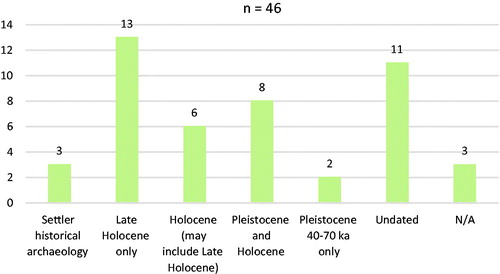It will come as no surprise to our readers that we publish a lot of papers on Australian excavations, and the stone artefacts that they produce. Continuing in our series of self-referential surveyettes, we thought we might have a look at what we have actually been publishing over the last three years. The table and bar charts below (, and ) provide a snapshot of the topics of our published papers, the periods of archaeological time they cover and a geographical breakdown.
Table 1. Topics covered by articles (36), short reports (9) and forum (1) in Australian Archaeology since 2015 (volume 81).
Figure 2. Geographical regions for articles published since 2015. *Includes Torres Strait and central Queensland coast.

As mentioned, the most frequent topics are Australian site reports (20%) and lithic analyses (23%), followed at a distance by rock art papers (12%). Historical archaeology, concerning European settlers rather than Aboriginal archaeology, comprises 7%, and other topics muster one or two apiece. It is interesting to see the spread in these, encompassing a range of topics that might be said to represent the discipline in Australia. This is obviously a small sample, and it could easily be expanded to cover the last ten years, or more (with more effort). It would also be interesting to make longer range comparisons and look at trends over time, but this will need to be a future undertaking. One impression might be that there are fewer faunal analyses than we have seen in previous decades, and fewer papers that are primarily concerned with environmental archaeology per se.
Looking at the (of course) arbitrary periods with which authors have concerned themselves (), it can be noted that, while public attention tends to focus on the Pleistocene, 4% of papers concern themselves with the Pleistocene only, and 13% are about the Pleistocene and Holocene. It would seem that topics focusing on the Holocene (41%) comprise the bread-and-butter of authors’ interests. These include the historical period as well as pre-Colonial times.
Australian archaeologists working on Indigenous topics are able to find meaningful things to say about archaeological material that is not firmly dated (24%) e.g. rock art, surface artefact concentrations, grinding patches, materials associated with oral traditions. By comparison, research articles published in the European Journal of Archaeology since December 2015 (n = 63) comprise few (4%) describing the analysis of strictly undated archaeological material. Archaeology which explores themes beyond establishing strict chronological sequences in favour of exploring how people lived and even thought in the past is alive and well in the pages of AA. Perhaps the rest of the world could take note of how we negotiate worthwhile research in this sphere.
Geographically (), nearly half of researchers’ effort would appear to be expended in northern Australia (38% in NW Australia and the top end, 9% in NE Australia), compared to 27% in southeast Australia (including South Australia and Tasmania). This is a definite shift within the last 20 or so years. We have also published a small but significant number of articles on ‘nearby regions’, including Papua New Guinea (two), Southeast Asia (one) and Norfolk Island (one, actually an Australian administrated Territory but culturally more Polynesian in the past, and to some extent the present; see the relevant article in our previous issue!). It is good to see, however, that most areas are represented in some way.
Style guide
By the time you are reading this, the new Australian Archaeology style guide will be available in the AAA website, and may even have been sent to you, if you are a member. Note that we have made many small changes, but perhaps the most significant one is a much expanded section on reporting radiometric ages, particularly radiocarbon and luminescence. We will treat the authors gently in the initial days of this change but will revert to our more normal grammar-nazi selves further down the track. Please check to make sure before you submit a paper that, first, the new style guide is available, and second, that you familiarise yourself with it, and then use it.
Department of Archaeology, School of Social Sciences, University of Western Australia,Crawley, WA, Australia
[email protected]

